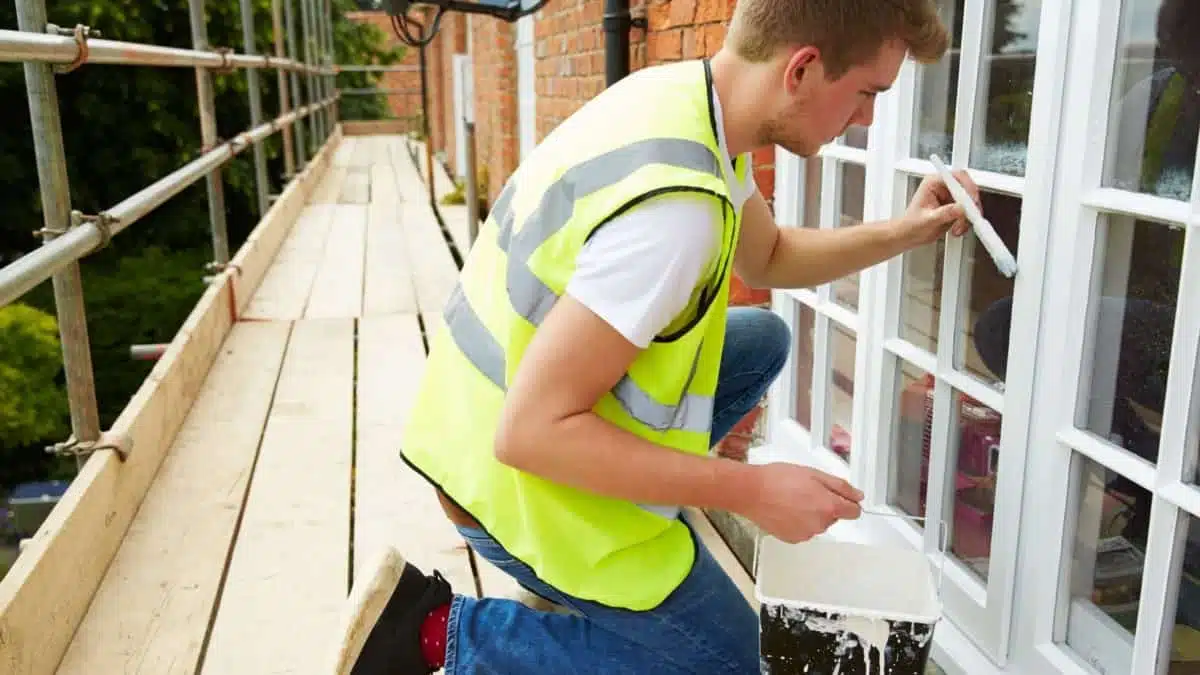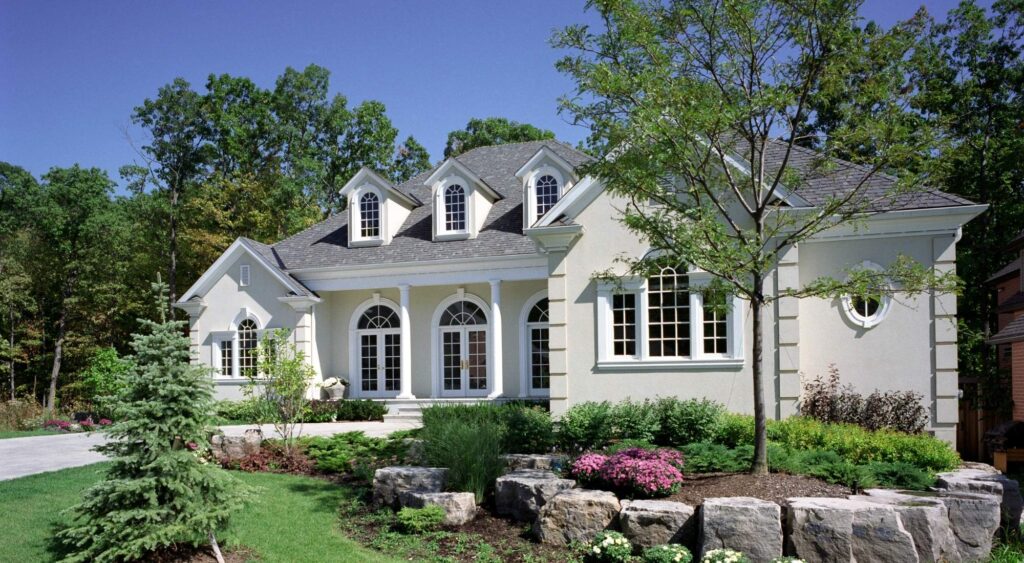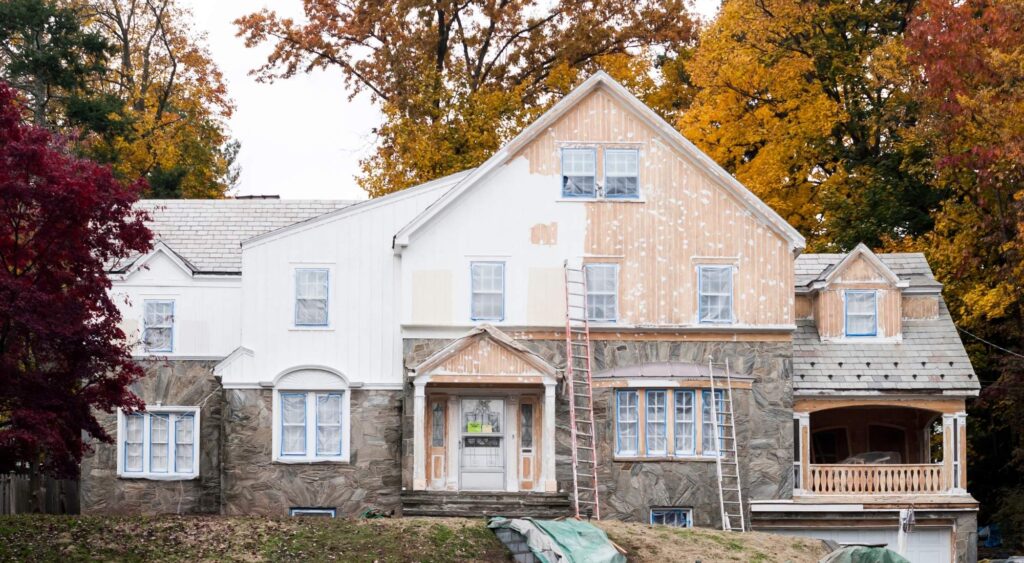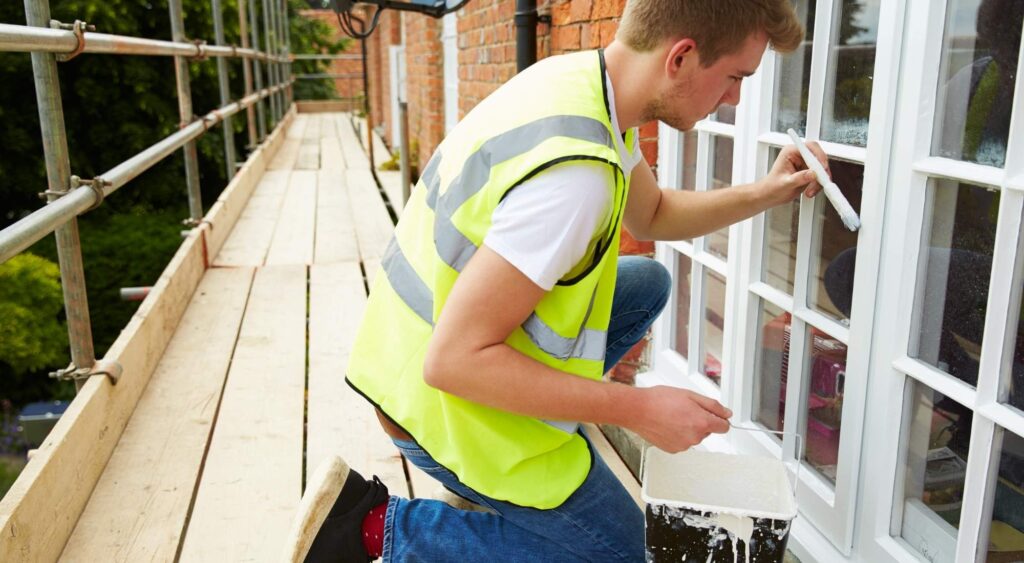How long does it take for paint to dry outside?
That is a great question and, unfortunately, there isn’t one straightforward answer to that question.
Finding all of the information you need to know about exterior paint’s dry times isn’t always a simple task.
If you are sick of searching a thousand different terms like …
- “How long does it take for outdoor paint to dry?” or
- “How long does exterior paint take to dry?”
… you can take a deep breath and relax. Two Brothers Painting is here to answer those questions and more.
Keep scrolling to discover what types of paints dry the fastest, what weather to avoid when painting, and what “curing” means.
Table of Contents
- Exterior Paint: Dry vs. Cured and Why it Matters
- How Long Does it Take for Exterior Paint to Dry?
- How Long Does Your First Coat Need to Dry Before Applying a Second Coat?
- 6 Factors That Can Affect Drying Time for Exterior Paint
- How Can You Make Exterior Paint Dry Faster?
- Two Brothers Painting: Exterior Paint Experts in Beaverton, OR
Exterior Paint: Dry vs. Cured and Why it Matters
When it comes to drying time for exterior paint, You may be surprised to learn that paint needs to do more than just dry.
In addition to drying, paint needs to cure. But what does that mean?
When the paint is no longer sticky to the touch, it is considered dry. But there is another step.
After drying, paint has to cure, which means all of the solvents have evaporated.
Cured paint is durable and leaves the surface hearty and much more weather resistant.
Depending on the type of paint you use, it can take only a few hours to dry. But curing takes longer. Some paints take up to 30 days to finish curing.
From sprucing up your siding’s look to helping weather-proof your home, exterior paint has a lot of benefits. But you only get those benefits if the paint has a chance to cure.
How Long Does it Take for Exterior Paint to Dry?
How long does exterior paint take to dry?
It depends.
Some paints are dry enough for a second coat in just a couple of hours. Other types of paint take much longer.
Latex-Based Exterior Paint Drying Time
Latex paint is a popular choice for several reasons, one of the main ones being its quick dry time. Depending on environmental conditions such as humidity, latex paint takes somewhere between one and three hours to dry.
You can usually add another coat about three to five hours after the previous coat.
With such a quick dry time, latex paint is the perfect paint… right?
Not necessarily. While latex paint succeeds in dry time, its curing time leaves a lot to be desired. Because it dries from the outside in, curing can take much longer than some other paints on the market.
In prime conditions, curing latex paint takes 14 days, at a minimum. In poor conditions, such as high humidity or extreme temperatures, latex paint can take upwards of 30 days to cure.
Oil-Based Exterior Paint Drying Time
Back in the day, oil-based paints were the favorite, but their popularity has slowly declined, and their long dry time seems to be at the center of their fall from favor.
Unlike quick-drying latex paint, oil-based paints take six to eight hours simply to be dry to the touch. Because drying takes so long, it is hard to do more than one coat in a day, and the project that easily could have taken a single day now takes three.
Despite its excruciating dry time, oil-based paints redeem themselves in the curing phase. Oil-based paints have an impressive cure time of only three to seven days, making them much, much faster than most other paints out there.
Because of their quick dry time, oil-based paints are a common choice for trim and floors.
How Long Does Your First Coat Need to Dry Before Applying a Second Coat?
You cannot add a second coat of paint until your first coat is fully dry to the touch. While it varies from paint to paint, this usually takes around three to ten hours.
Various factors contribute to dry time. Here are the main ones:
- Wind
- Weather
- Temperature
- Humidity
Latex-Based Paint
Latex paints need a minimum of three to five hours for the first coat to dry. You may find that your paint is dry in only one to three hours, but you must make sure the paint is fully dried before you add the next coat. Waiting a couple of extra hours is a good practice.
Oil-Based Paint
If you use oil-based paint, get ready to wait a while for it to dry. Typically, you should give it eight to ten hours of dry time before you apply the second coat. Oil-based paints are often dry to the touch in only about six to eight hours but, again, it is better to give it a couple of extra hours to ensure that the paint is fully dried.
It is not uncommon to wait overnight for oil-based paints to dry.
6 Factors That Can Affect Drying Time for Exterior Paint
When it comes to the drying time for exterior paint, it all hinges on factors that you typically cannot control.
From the weather that week to the primer you use, paint time varies greatly.
Here at Two Brothers Painting, we know what each type of paint needs in order to dry and cure properly. Understanding all of the important factors that play into paint dry time is difficult, but we know a thing or two about each of them.
Here are the top six things that affect paint dry time.
#1: Temperature
When painting exteriors, outdoor temperatures matter greatly. If the temperature is not in the correct range, your paint is not going to dry very well.
If you opt for a chilly autumn day when the temperature falls below 50 degrees, you will find those estimated dry times increase by leaps and bounds. When your paint finally dries, there is a high probability that it won’t look quite as good as you hoped it would.
But the opposite isn’t any better.
It is a sunny summer day and the thermometer on your porch is reading a toasty 90 degrees. You throw on your dingy old t-shirt and paint-splattered jeans before grabbing your paintbrush and heading outside. You spend the next three hours repainting your porch, and it looks great… for a short time. It doesn’t take long for the paint to start peeling and looking shoddy.
What happened?
When it is too hot outside, especially if the humidity is super low, the paint dries much too quickly and does not have the time it needs to properly adhere to the surface you are painting on. This means the paint won’t stay in place for nearly as long as it should, and you probably won’t be very happy with the end result.
Just like most people, the average paint tends to function best on a clear day when the temperatures are between 50 and 85 degrees. But there are outliers, so before you start painting, always give the paint can or manufacture’s website a once-over to make sure the temperatures are okay for your specific paint choice.
#2: Rain or Snow
The opponents square off and look each other in the eyes. Rain’s glare is menacing, and you can tell that she is used to winning. Paint’s face is full of fear, and it is clear that he rarely wins in this match-up. As the two go at it, the winner is obvious. Rain knocks Paint to the ground, and the battle is over, almost before it begins.
This tale of an epic battle might be a little too dramatic, but make no mistake, rain and snow can do some pretty dramatic things to wet outdoor paint.
If it rains on your freshly painted house, you may find that the rain washes the wet paint right off. If the paint is a little drier, you may find that the rain makes it slick and slimy. This is due to surfactants — a type of soap — in the paint that are added during production to keep the paint from sticking to machinery.
Surfactants don’t take away from the quality of the paint, but if the paint gets wet before it has cured, it will release these surfactants, and you will find yourself with a slippery, soapy mess.
Snow can have a similar effect. Besides, if it is cold enough to snow, chances are it is too cold to paint.
You should do everything you can to keep your paint as dry as possible for a minimum of 36 to 48 hours.
#3: Humidity
Humidity is wet paint’s arch-nemesis.
If you step outside to paint and find that humidity levels are above 50%, put the paint down and back away slowly. This is not the day.
Paint dries when the air around it absorbs the moisture in it. But if the air already has a lot of moisture, it cannot absorb more, and you will find it hard to get the paint to dry properly.
In case that isn’t bad enough, humidity is often to blame for drips and streaks.
Humidity and wet paint don’t mix.
#4: Wind
How long does outdoor paint take to dry?
That depends on wind speeds.
In addition to making it too dangerous to climb your ladder to reach the top of your house while painting, high wind speeds can cause some issues with wet paint.
If the wind is particularly boisterous, you may find yourself dealing with ripples in your paint. High winds also tend to blow debris around and that debris often sticks to wet paint.
For instance, you might find that mother nature adds some spice to your project in the form of:
- Fallen leaves
- Freshly mown grass
- Dust; or
- Trash from the neighbor’s tipped-over trash can
If you decide to break out your new paint spray gun on a windy day, get ready because everything will be covered in paint by the end of the day. Everything, that is, except for your house. The wind blows the paint onto every surface — including your favorite jacket — except for the house.
#5: Thickness
As a rule, thick paints and coats take longer to dry.
Some paints are naturally thicker, and some application methods tend to lay on thicker layers.
Be sure to think through how thick your paint is and how that will affect drying time before you assume that it will be dry enough by the time that mid-week thunderstorm the weatherman keeps talking about rolls in.
#6: Primer
Primer is a key part of a quality paint job. Some paints have primer mixed directly in, which makes your job much easier.
But there are still a good number of paints that require a couple of coats of primer before you can use them.
Primer has a lot of perks, including making the paint more durable.
The good news about primer is that it dries fairly quickly. About 30 minutes to an hour will see your primer dry to the touch. But the primer takes another three or so hours to cure.
Unlike paint, primer has to be completely cured before you can add the second coat. Before you begin your project, make sure you set aside enough time to handle your primer needs.
Always make sure you closely follow the directions given for both the primer and the paint.
How Can You Make Exterior Paint Dry Faster?
You can try using hair dryers or infrared heaters on smaller sections that are taking too long to dry, but the best option is to paint when the temperature is on the warmer end and you have low humidity. Accelerating the exterior paint drying process is not as easy as it is indoors.
You can always try using fans or heaters, but you should be careful to make sure that you are not making the surface too hot or blowing debris into your new paint job.
Two Brothers Painting: Exterior Paint Experts in Beaverton, OR
Exterior painting and dry time can be complicated. DIY exterior painting is possible, but it is a task better left to the experts.
With over 145 years of combined experience, Two Brothers Painting has the experts you are looking for. We are a Portland-based company that is proud to be family-owned.
We treat our customers like we would want to be treated, and we paint their homes as if they were our own.
Two Brothers Painting is reliable, professional, and ready to help you boost your home’s curb appeal.
Schedule your estimate today.





